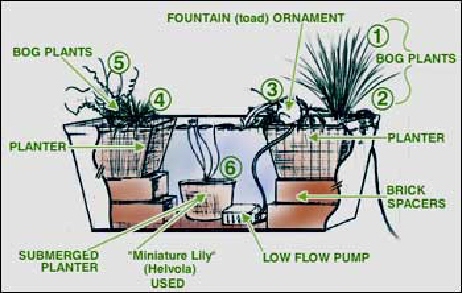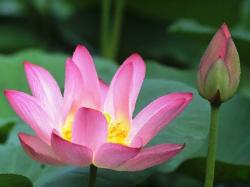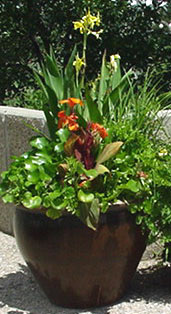Explore
the World of Water Gardening
Looking for a new and fascinating way
to grow and enjoy plants? How about
exploring the small world of container
water gardening? The color and fragrance
of container-grown aquatic plants can
transform even the smallest space into
a living work of art. Don't let lack
of experience, space or time put a damper
on this gardening project. All you need
is an hour or two, a suitable container,
some lovely aquatic plants, and a sunny
place on your patio, deck or porch.
Getting
Started
Choose
a Container -
The first step in planning your water
garden is to decide on a container.
Just about anything that holds water
qualifies. Container water gardens can
range from a small ceramic bowl holding
a few gallons of water to a much larger
tub, pot, basin or wooden barrel.
As a general rule, the container should
hold at least five gallons of water,
be 18 inches wide at the top and 18"
deep. When choosing your water container,
consider size, weight, location, mobility,
price and types of plants you want to
grow. If you want to use a favorite
vessel with drainage holes, just plug
them up with an inexpensive cork or
a piece of heavy plastic liner spread
with caulk. Wooden containers can be
lined with heavy duty plastic film or
flexible pond liner.
Some good container choices are:
The most pleasing designs can be created
with only a few plants. Start with a
focus plant, such as a miniature water
lily, water poppy, floating heart or
water snowflake. Some other good focus
plants include pigmy lilies, teacup
lotus and dwarf lilies. You'll be surprised
how many flowers you'll get from just
one of these surface-blooming plants.
Next, consider a floating plant. Water
lettuce, water chestnuts, fairy floating
moss and water hyacinth are all good
choices for containers because they
help suppress algae and catch debris
floating in the water. Be aware that
most floaters reproduce rapidly and
need to be culled from time to time.
Depending on the size of your container,
you may want to include a vertical growing
plant to show standing leaves above
the water. A few favorites include water
iris, horsetail grass, umbrella palm,
cattail, cardinal lobelia, Japanese
arrowhead and cotton grass. As you gain
experience, you can experiment with
greater numbers and varieties of plants.
Pick a Sunny
Spot
Container water gardens permit you
to get close enough to appreciate the
spectacular flowers and vibrant scents
of aquatic plants. Pick a sunny spot
on your deck or patio, where you can
keep an eye on the container and its
contents. Tub-type containers can also
be tucked into a bed of flowers, or
placed on the porch near your front
door.
Water gardens are healthier in sunny
locations. Most aquatic plants require
a good dose of sun, and should receive
from four to six hours of full sun every
day. Lilies, lotus and other blooming
water plants prefer morning sun, as
do plants growing in small or shallow
containers. Although the best location
for a water garden is in an open, sunny
area, try to select a spot that's protected
from wind.
Place your container on a level surface
for both visual effect and to maintain
proper water level. Use bricks or garden
stones to provide a level, stable foundation
for heavier containers. If you are planning
to use moving water, make sure there
is a convenient supply of electricity
and fresh water close by.
Pot Some Plants
Although your water garden will have
a few floaters, you will need to pot
up other varieties of aquatic plants
before sinking them in the water container.
Use sturdy plastic or terra cotta pots.
At the nursery we usually have those
black plastic pots that our plants come
in - these can also be used - and they're
free! Water plants should be grown in
a 50/50 mixture of bagged topsoil and
clay soil. Don't use a light-weight
commercial potting mixture.
| To
pot plants and sink them in the
water: |
|
|
|
- Remove the plant from
its original container
and rinse thoroughly to
wash away any insects.
- Partially fill the pot
with soil mixture and
gently position the plant.
Fill in with additional
soil mix, leaving about
an inch below the rim.
- Spread a layer of pea
gravel or aquarium gravel
on the top of each newly
planted pot to keep soil
from muddying the water.
- Slowly lower the pot
into the water at a slight
angle, allowing time for
air to escape without
displacing dirt.
- To position an aquatic
at just the right depth
in your container, simply
set it on a brick or two.
Keep the plant high enough
so that its leaves sit
above water.
- Add free-floating plants
such as water hyacinth,
to the container after
potting up and positioning
other aquatics. Simply
float them in the water
- they don't need any
soil. They have beautiful
flowers and keep the water
clear of algae and weeds
by minimizing the amount
of sunlight on the surface
of your container garden.
Remove excess floating
plants by lifting them
above the water and cutting
off unwanted parts.
|

|
|

Water lilies are fragrant
perennials or annuals
with big, round leaves
and showy flowers that
float on still water.
You don't have to invest
in a pond or submerged
water garden to enjoy
their continuous color
from late spring until
frost. Just buy a pretty
pot and plant one variety
of small water lily.
-
Use
almost any large glazed
or ceramic container
to make a beautiful
home for miniature water
lilies. It's best to
select a pot that is
at least 18 inches high,
18 inches wide and without
drain holes.
-
If you
want to use a favorite
vessel with drainage
holes, just plug them
up with an inexpensive
cork or a piece of heavy
plastic liner spread
with caulk.
-
Place
the container in a sunny
spot on your deck or
patio.
Fill with water and
wait two days before
planting to make sure
it is waterproof.
Put each lily in a plastic-mesh
planting box and gently
submerge into the clean,
watertight container.
You may also plant the
water lily in a small
container using a 50/50
topsoil/clay mixture.
-
Use
a brick or a small inverted
clay pot to raise the
lily high enough so
that all leaves will
sit above water level,
then sit back and enjoy
the show!
|
|
|
| |
|
|
|
Care For Your
Water Garden
Taking care of your container water
garden is usually a simple matter. There's
no need to change the water, but do
top it off every few days to replace
liquid that has evaporated. Check to
make sure the plants are thriving every
time you add water. If you see a wilted
or dying plant, it's likely the garden
isn't getting enough light and should
be repositioned.
Because water plants grow quickly,
use fertilizing tablets sparingly -
if at all. TIP: Never fertilize new
plants until they show signs of growth.
Carefully cut off spent flowers to
promote continued blooming and to keep
your water garden tidy. Dip out any
debris or fallen leaves and thin by
removing overgrowth every few weeks.
TIP: Before subnersing your water plants,
plant them in small pots to limit growth
and trim off any dead or diseased areas.
Favorite Aquatic Plants
No matter the size, any container water
garden will look best when a variety
of plants are brought together. You
can use a tall plant for drama, a flowering
plant for color, a cascading plant to
extend blooms outside the container,
and a floating plant to top off your
creation.
Vertical Foliage Plants:
SWEET FLAG - a grassy plant with fruity
fragrance that grows 2 or 3 feet tall.
DWARF PAPYRUS - bell shaped flower clusters
atop 18 to 24 inch stems.
CATTAIL - 4-foot spires of foliage topped
by brown flowers that look like sausage.
Fantastic Floaters:
WATER LETTUCE - palm-sized plant with
soft, wrinkled leaves with a velvety
texture.
WATER HYACINTH - lilac-blue flowers
bloom about 6 inches above the surface.
FLOATING MOSS - tiny floater that's
ideal for small container water gardens.
Cascading Plants:
WATER MINT - fast-growing with fuzzy,
round leaves and tiny, powder blue flowers.
PARROT FEATHER - soft, feathery tufts
of foliage trail over the edge of the
container.
Magical Marginals:
VARIEGATED SPIDER LILY - green and white
leaves with fragrant, white blooms.
CHAMELEON PLANT - a spreading, delightful
mound of red, green and cream leaves.
YELLOW PITCHER PLANT - trumpet shaped
leaves with white and red veins.
WATER CELERY - provides fragrance and
delightful, green and pink foliage.
Adding Fish
Add a few fish to your water garden
for extra appeal. Guppies, mollies,
swordtails, mosquito fish and small
gold fish are commonly available and
live happily in a small container. These
little fish not only add interest, they
help keep plants healthy by eating aphids,
mosquitoes, and other insect pests.
Wait one or two weeks after planting
the container to add fish. During this
time, your water garden will grow enough
beneficial algae to provide a healthy
environment for a few fish.
Limit the number of fish you select.
The larger the container, the better
it is for even the smallest fish specimen.
For example, a whiskey barrel half is
adequate for only four or five tiny
fish.
To reduce stress caused by the variation
in water temperature, float the bag
you bring the fish home in on the surface
of the container for about 30 minutes.
Before releasing them, add small amounts
of container water to the bag to acclimate
your fish to their new home.
It's likely there will be enough food
in the container water garden, including
wayward insects, to support a few fish.
But if you need to add supplemental
food, watch to see if the fish are actively
swimming before feeding them for the
first time.
Other than replacing water that evaporates,
and fertilizing and trimming your plants,
there is little maintenance involved.
Unless you live in an area where the
winter temperatures do not drop below
freezing you will need to dismantle
your tub garden or take it inside for
the winter.
 |
Swamp
in a Pot
Do you know you can grow water
plants in a containerized miniature
swamp? It's true and it's the
simplest form of water gardening
you can think of. All you need
is a traditional terra-cotta pot,
pea gravel, potting mix and a
couple of water plants. If the
pot has a drain hole(s) line it
with heavy duty plastic film or
a piece of pond liner. |
For best results, treat the pot as
if it were a miniature swamp.
Fill the container at least two-thirds
full of 50/50 potting mix/clay soil
mixture, add the plants, top them off
with pea gravel, and then add water.
Make sure the plants stand in 6 inches
of water or less.
You can find many moisture-loving
perennials available at the nursery
suitable for 'swamp container gardening'.
NOTE:
If your little swamp attracts mosquitoes,
add a drop of cooking oil to the water
every couple of weeks. It creates a
film over the water surface that is
harmless to plants but prevents mosquito
larvae from coming up for air.